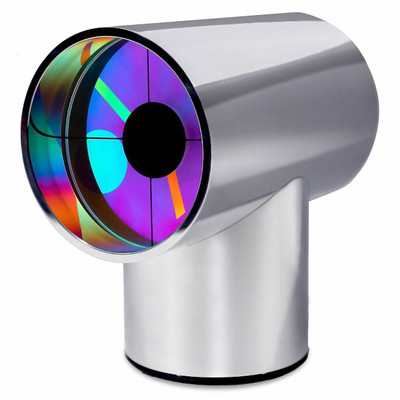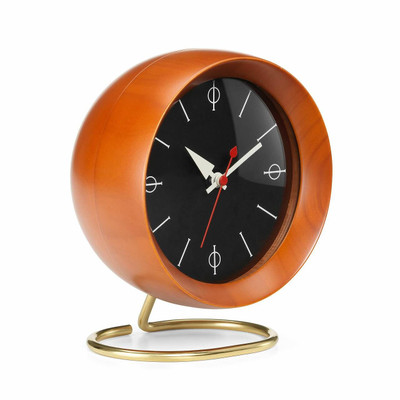-
About This Work
Note: The manufacturer has since updated this model with slightly larger hands and second disc, so the time is easier to read.
From the Kirsch-Hamilton 1970s family of clocks with mysterious shifting colors. Prisma is the perfect desktop sculpture for any contemporary or mid-century modern home. With a larger display than its better known sibling, Aurora, the Prisma provides a splendid light show while displaying time. The clock face and overlapping secondhand disk continuously change colors as time passes. Color shifts also occur relative to ones movement around the clock. Even once you become familiar with the color shifts (though like us, maybe never the science), the color combinations continue to delight and surprise. The Prisma TL has been designed to come as close as possible to the original Prisma from the 1970's, but with the improvement of the LEDs for the internal light source (no fluorescent lamps to replace) providing a broader spectrum and more saturated colors. Translation: it's more interesting to watch than the original.
THE CASE
The Prisma TL contains a 5/8" thick polished acrylic front true to the original design with a sturdy matte black finish case. The only superior case in its history was the version with a chrome plated steel case. If you have this version, you may want to keep it and have new parts installed. The manufacturer recommends the Prisma TL over any current variations. It is truest to the original design and most popular. The base also contains scratch resistant rubber feet.THE CLOCK
The biggest improvement in Gamble's models is the light source. The current Super Flux variable spectrum LED has a cooler running temperature, broader and more saturated color gamut, and the option to adjust the brightness. Also, the color changes more frequently (every 17 seconds vs 30 seconds) and less predictably than earlier models. 80% of the color changing is still from the rare birefringent filters; the LEDs add the remaining 20% effect. Without the filters, the hour & minute hands and second hand disk would all be the same color for each transition. The LEDs enhance (not replace) the polarizer technology. The polarized light technology is still what makes the Prismas unique. The strong, metal geared clock motor is by the Hansen Corporation—the same (now hundred year old) US company that made them in the 1970's. The motor has a life expectancy of around 20 years, while the LED lights generally become 30% dimmer in 15-20 years.HISTORY OF PRISMA
In 1970, ex-NASA physicist Jordan Kirsch and architect Jim Hamilton (who worked on the McDonnell Douglas DC-10 cabin around this time) patented the concept for a clock that used birefringent materials in a polarized light field. The result was a clock called Spectrum manufactured by Rathcon (Around 5,000 made; Rathcon also manufactured the Orbita clock at this time). Unsatisfied with the manufacturing quality at Rathcon, Kirsch-Hamilton re-designed and re-named the clock the Kirsch-Hamilton Aurora and moved production to Newton Plastics (NPC) in Newton, MA. The Spectrum and original Aurora used an incandescent lamp that caused the clock to run very hot and shortened the life of the motor and filters. During this time Kirsch-Hamilton also designed the Prisma & Spectra. This family of color-shifting clocks was manufactured and marketed from 1970-1990. The marketing company Hampton-Haddon bought the rights in the late 1980s before eventually losing interest and discontinuing production.In 1993, engineer and horologist Barry Gamble (ChronoArt) started manufacturing Luminas (a polarized light clock) and in 1994 began repairing Auroras and Prismas after Kirsch-Hamilton Repair disappeared in 1992. In 2001, he introduced the Prisma II, an updated version of the Prisma clock from the 1970's with cooler running and longer lasting LED technology. In 2012, he improved the II with the Prisma TL by using a thick edge polished acrylic front that is truer to the original version than the II. The version featured on our website is the most popular and recent Prisma model; it ships directly from the manufacturer.
-
Technical Specs
- PRISMA TL
- Handmade in Cotati, California USA
- Dimensions: 7.25h x 7w x 6d in (18.4 x 17.8 x 15.2 cm)
- Weight: 8 lbs (3.6 kg)
- Hansen Corporation metal geared clock motor
- Precision: ±2 seconds/month (if power is maintained)
- Power Supply: 120 VAC 60 HZ, 10 WATTS (contact us for info on 230 VAC, 50 HZ)
- FUNCTIONS
- Adjust time
- LED dimmer control
- Color changes every 17 seconds
- Rotating quarter wave retarder (second hand disk)
- OPTICS
- Super Flux Variable Spectrum LED & microprocessor
- Red, Blue, Green and White LEDs (20 each)
- Birefringent filters
- LEDs will dim only by 30% in 15-20 years
- CASE
- Sturdy matte black acrylic case
- 5/8 inch thick polished acrylic front
- Scratch-resistant rubber feet
-
Quick Help & Manual
-
Download manufacturer manual
- Prisma TL Manual (pdf)
-
Setting the time
- Turn the setting knob on the back counterclockwise. You may turn it clockwise, but it may loosen the knob.
-
Adjusting display brightness
You may want to dim the clock for bedroom use, to extend the LED lifespan, or simply for a setting you most enjoy.
- On the back of the clock, about 2 inches to the left of the time setting knob, you will see a hole. The size of the hole is just right for the eraser end of a pencil. Through the hole, you'll see a small black switch on the circuit plate.
- With the eraser end of the of pencil, gently locate the button (you'll feel it press in when you get it); push and hold the switch in with the eraser end until you reach the desired brightness.
- Each time you push down the switch post, the bright-dim direction will reverse.
- If you wish to use the clock at very low brightness (such as for bedroom use) unplug the clock, wait 20 seconds, then hold in the switch while plugging the clock in. This will smooth out color changing; then set the brightness. It’s a little tricky how fast it changes near minimum brightness, our apologies.
-
Cleaning
Clean the case with any acrylic plastic cleaner. DO NOT use abrasive cleaners
-
Extending the LED lifespan
After 15-20 years, the LEDs will lose about 30% of their brightness. After 20 years, the clock motor will probably fail. The Prisma TL runs much cooler than the original and is the longest lasting model yet. Displaying your clock at a lower brightness level (but bright enough so that you enjoy it to its fullest) will help extend the LEDs life.
-
Avoiding moisture
Going on vacation? Leave the clock plugged in & use the button in the rear to dim the lights. The small warmth in the clock will help keep moisture out.
-
Return policy
We do not offer full refunds for Prisma purchases, unless your clock arrives damaged or is malfunctioning. We will accept a return within 30 days if the clock is returned in original, unused condition. Buyer pays return shipping plus 10% restocking fee.
-
Warranty & repairs
Prisma TL is guaranteed against defects under normal use, for 1 year on parts & labor from the date of purchase. All repairs are done at the factory. We recommend keeping the box and packaging materials for at least 90 days. If something goes wrong, it will likely be during this period.
If you wish to repair a previous version for sentimental reasons or have a chrome plated steel case you do not want to part with, contact us to be connected with the world-authority.
-
Download manufacturer manual
-
Pre-Sale Questions
Email or call the gallery with any question 1-704-981-0636


















